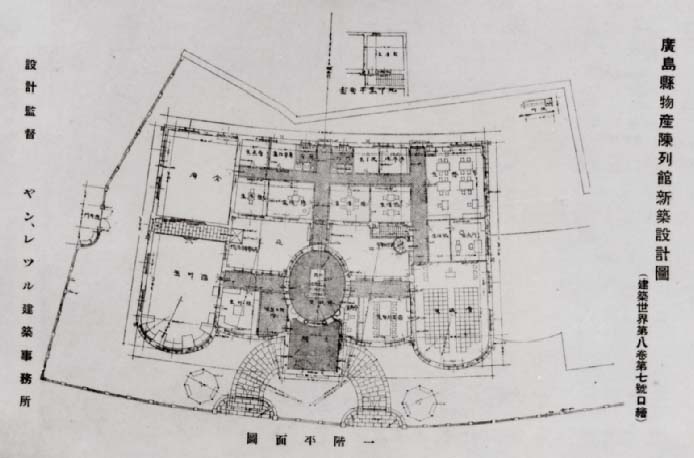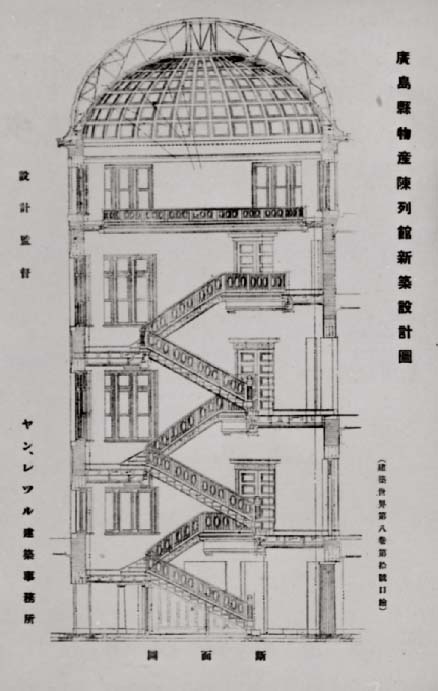
On April 21, 1914, a prefectural announcement that the Hiroshima Prefectural Commercial Exhibition Hall was to be located in Sarugaku-cho in Hiroshima City was released, and an inauguration ceremony took place on the western drill grounds on April 5, 1915. During a 40-day period, starting that day to May 14, the Hiroshima Prefectural Products Promotion Fair was held with the completed hall serving as one of the fair sites and one part of the Western Drill Grounds serving as another. In the same year on August 15, an opening ceremony was held for the renamed building as the Products Commercial Exhibition Hall. At the ceremony Mr. Terada, governor of the prefecture, gave the following message: "The building will serve to further promote and improve the prefecture's products and contribute to the development of related industries." After the opening ceremony, the hall was opened to the public and the building's original work began.

Plan of the Dome (Source: Architecture World Magazine)

Section of the Dome (Source: Architecture World Magazine)
After the opening of the building, on January 1, 1921, the Hiroshima Prefectural Commercial Exhibition Hall's name was changed to the Hiroshima Prefectural Products Exhibition Hall. On November 1, 1933, the name was once again changed to the Hiroshima Prefectural Industrial Promotion Hall. The reason the names were changed was that "due to the development of the times, it was extremely inefficient to just sell. It is therefore necessary to break out from the limitation of merely the display of products that has been employed in the past." With the aim of industrial promotion, on April l, 1934 representative offices were established in the northeast area of China in Dairen, Xinjing and Harbin. Similarly, on April 27, 1938, offices were added in Fengtian, Tianjin, Shanghai and in Kobe, Japan. On November 24, 1938, in the Industrial Promotion Hall, the Hiroshima Prefectural Central Commerce Consultation Office was established, bringing about the building's peak in activity.
The activities carried out in the hall, at that time, were such functions as the collection and exhibition of products and sample goods from other prefectures and counties, the offering of surveys and consultations regarding commerce and industry, the provision of materials, and the display of newspapers and magazines regarding the introduction of business and the manufacture of designs. During the 11 months after the opening of the hall in August 1915 to June 1916, a total of 157,000 people visited the facility, a smooth start considering the 9.79 million yen worth of commissioned sales. Permanent exhibitions were also carried out in the hall, including the notable exhibition titled "Dolls From America," which drew 40,000 visitors during its four-day run starting April, 1927. From March, 1929 to May 13 of the same year, the building became the supporting site for the Showa Industry Exposition, and from April 29, 1932 to May 15, 1932, at the Timephase Exhibition it was established as the second site of the Japan-Manchuria Trade Exhibition.
Exhibition Room (Inside of the Dome)
You can look the CG of the interior of the dome.
http://www.joho-yamaguchi.or.jp/mac/3DLOOKb_english.htm
Tindustry, it played the role of exhibition hall and art he Hall not only encouraged museum by providing a for the promotion of Hiroshima's culture. For special site exampleopening, from May 15, 1916 to May 30, 1916, , in the year following the building's the Exhibition took place, and every year thereafter the 1st Hiroshima Prefectural Arts hall served as the annual exhibition. In addition, in 1929, during the Showa site for this Industrial ExhibitionArts Exhibition," which was sponsored by the , the "Showa Hiroshima Prefectural Arts was held in the same hall. The exhibition Association, included many works of art from from all over the country, breathing new leading artists life into the art world of first exhibition of the Western Art Hiroshima. In 1933, the Association was heldexhibition of the "Geishu (Hiroshima) Arts , and 1936 saw the first Associationdeepening of involvement in World War II, such ." In conjunction with the exhibitions became example, the "Wounded Soldier Contribution tinted by war. For Exhibitionin 1942, an exhibition of war art titled the ," in 1937 was held in the hall, and "many people.Holy War Art Exhibition," took place, drawing
Nevertheless, with the closing of such offices as the Dairen office on May 1941, the scope of the hall's activities began to contract. The focus of the activities of the hall was changed by the revision of hall regulations on June 27, and with Japan's further deepening involvement in the war, the hall was managed with a focus on the promotion of industry, When the war became even more severe, the exhibitions held in the hail gradually were scaled down, and finally, on March 31, 1944, all activities at the hall were halted. The hall then housed offices for such government-related agencies and unions as the Interior Ministry's Chugoku-Shikoku Public Works Office and the Hiroshima District Lumber Control Corporation.